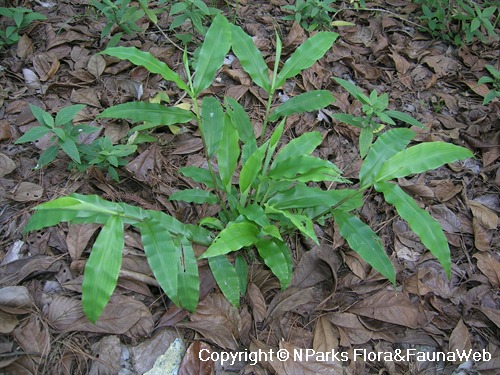
Back
Centotheca lappacea (L.) Desv.
| Family Name: | Poaceae (Gramineae) |
| Synonyms: | Cenchrus lappaceus L., Centotheca longilamina Ohwi, Centotheca parviflora Andersson, Festuca blepharophora Roem. & Schult., Holcus latifolius Osbeck, Melica diandra Roxb., Melica lappacea (L.) Raspail, Melica philippensis Llanos, Melica refracta Roxb., Oplismenus magellanicus (Lam.) Roem. & Schult., Panicum festuciforme Hochst. ex Hook.f., Panicum magellanicum Lam. |
| Common Name: | Rumput Darah, Rumput Lilit Kain, Barbed Grass |
Rumput Darah (Centotheca lappacea) is an erect, perennial native grass growing up to 0.3 - 1 m tall. It produces panicles of spikelets borne on the tip of their culms.
Name
Classifications and Characteristics
| Plant Division | Angiosperms (Flowering Seed Plants) (Monocotyledon) |
|---|---|
| Plant Growth Form | Grass or Grass-like Plant (Short Grass (Poaceae)) |
| Lifespan (in Singapore) | Perennial |
Biogeography
| Native Distribution | India to Polynesia and Australia (Queensland). It can be found in many parts of Singapore, including Changi, MacRitchie, Pasir Panjang-HortPark, and Pulau Ubin. |
|---|---|
| Native Habitat | Terrestrial (Freshwater Swamp Forest, Disturbed Area / Open Ground) |
| Preferred Climate Zone | Tropical |
| Local Conservation Status | Native to Singapore (Least Concern (LC)) |
Description and Ethnobotany
| Growth Form | It is an erect, perennial grass growing up to 0.3 - 1 m tall. |
|---|---|
| Foliage | The leaves are linear to lanceolate, reaching 5 - 21 cm long and 10 - 35 mm wide. The leaf blades are smooth or pilose (covered in long hairs) with an asymmetrical base that tapers towards the midrib. The leaves are arranged alternately along the stem or culms. |
| Stems | The culms (aboveground stems of grasses and grass-like monocots) are thin and wispy, up to 0.3 - 1 m. |
| Flowers | The flowers are known as florets and consist of heavily reduced petals and sepals, anthers, and stigmas. 2-4 florets are clustered together, forming a spikelet, and arranged along the stem; this inflorescence is known as a panicle, growing up to 25 cm long. |
| Fruit | The fruit is an ellipsoidal caryopsis (a type of dry, indehiscent fruit, commonly known as a grain) up to 1 mm long. The backwards-bending bristles on the lemma attract themselves to the fur of animals and to clothing. |
| Habitat | It can be found in swamps, open places in rainforests and along shaded roads and fields. |
| Associated Fauna | The fruits and seeds are most likely dispersed by passing animals and humans. |
| Cultivation | It can be propagated by seeds and division. |
| Etymology | The genus Centotheca means "prickly container", referring to the bristly spikelets. The specific epithet lappacea means "bur-like", referring to the backwards-bending bristles on the lemma (the outermost of two bracts enclosing a grass floret). |
| Ethnobotanical Uses | Others: An excellent fodder grass, used for livestock feed. |
Landscaping Features
| Landscape Uses | General, Parks & Gardens, Reforestation |
|---|---|
| Thematic Landscaping | Naturalistic Garden, Wildflower Garden |
Fauna, Pollination and Dispersal
| Seed or Spore Dispersal | Biotic (Fauna) (Vertebrates (Other Mammal), Vertebrates (Human)) |
|---|
Plant Care and Propagation
| Light Preference | Semi-Shade |
|---|---|
| Water Preference | Moderate Water |
| Plant Growth Rate | Fast to Moderate |
| Rootzone Tolerance | Heavy Clay Soils, Fertile Loamy Soils |
| Propagation Method | Seed, Division |
Foliar
| Foliage Retention | Evergreen |
|---|---|
| Mature Foliage Colour(s) | Green |
| Mature Foliage Texture(s) | Smooth, Velvety / Furry / Tomentose |
| Foliar Type | Simple / Unifoliate |
| Foliar Arrangement Along Stem | Alternate |
| Foliar Shape(s) | Non-Palm Foliage (Lanceolate) |
| Foliar Venation | Parallel |
| Foliar Margin | Ciliate / Hairy |
| Foliar Base | Oblique / Asymmetrical |
| Typical Foliar Area | Microphyll ( 2.25cm2 - 20.25 cm2 ) |
| Leaf Area Index (LAI) for Green Plot Ratio | 3.5 (Shrub & Groundcover - Monocot) |
Non - Foliar and Storage
| Stem Type & Modification | Culm |
|---|---|
| Root Type | Underground (Fibrous Root) |
Floral (Angiosperm)
| Flower & Plant Sexuality | Bisexual Flowers |
| Flower Colour(s) | Green, Brown |
|---|---|
| Flower Texture(s) | Gloss / Shiny, Smooth |
| Flower Grouping | Cluster / Inflorescence |
| Flower Location | Terminal |
| Flower Symmetry | Asymmetrical |
| Inflorescence Type | Panicle |
| Flowering Period | Free-Flowering |
| Flowering Habit | Polycarpic |
Fruit, Seed and Spore
| Fruit Classification | Simple Fruit |
|---|---|
| Fruit Type | Indehiscent Dry Fruit , Caryopsis / Grain |
| Mature Seed Colour(s) | Brown, Green |
| Seed Description | Ellipsoidal, measuring about 1 mm. |
References
| References | Veldkamp, J.F., Duistermaat, H., Wong, K.M., & Middleton, D.J. (2019). Poaceae (Gramineae). Flora of Singapore, Volume 7. Singapore: National Parks Board. 219-501 pp. |
|---|
Image Repository
Others
| Master ID | 501 |
|---|---|
| Species ID | 1797 |
| Flora Disclaimer | The information in this website has been compiled from reliable sources, such as reference works on medicinal plants. It is not a substitute for medical advice or treatment and NParks does not purport to provide any medical advice. Readers should always consult his/her physician before using or consuming a plant for medicinal purposes. |

